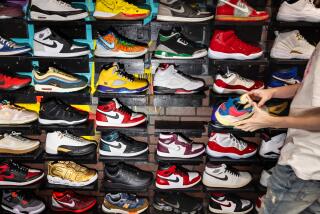Changing Styles Wear Down Boot Town
- Share via
NOCONA, Texas — After a hard cattle drive across Texas, cowboys who worked the Chisholm Trail 100 years ago would be sure to stop at this Oklahoma border town to pick up their handmade boots.
In the years afterward, boots made in Nocona became famous, as much for their history as for their high-grade leather and the stacked heels that fit in stirrups.
Today, changing consumer tastes have sapped the boot business so much that Justin Industries, which owns the Nocona factory and one in Fort Worth, is closing both of them, putting about 260 people out of work.
“The Western and Western-influenced products haven’t been in demand,” said David McGrady, general manager of the Nocona factory. “Everything is fashion-driven and, obviously, Western is one fashion that’s either in or out.”
Sales of Western boots have always been cyclical. Popular in the early 1980s because of the movie “Urban Cowboy,” the traditional 13-inch-high dress boots have found less appeal in the ‘90s.
Justin Industries said its total 1997 footwear sales, including brands such as Nocona, Tony Lama and Justin Ropers, fell 16% from the previous year. The company reported $186.5 million in footwear sales that year.
Some of the country’s largest cowboy boot makers have been switching to boots with more of a work style, such as the flatter-heeled ropers. Many are making lace-up boots, although the tire-tread-like soles won’t do for two-stepping at the dance hall.
For Nocona, a town of 2,800 south of the Red River, the closing of the factory means the end of the area’s largest employer and its biggest taxpayer. The 160 workers make about 3,500 pairs of high-end boots each week, ranging in price from $200 to $1,100.
For townsfolk, the boot company has been not only a primary source of income but also a piece of a legend.
“The sad thing, apart from the loss of jobs, is that it was kind of our identity,” said Ricky D. Howard, president of Nocona Banking Center.
Both the town and the boot are named after Chief Peta Nocona of the Comanche tribe.
J.J. “Daddy Joe” Justin opened the business in the 1880s. After he died, the Justin family moved it to Fort Worth.
Justin’s daughter, Miss Enid, felt so strongly that her father wanted the company in Nocona that in 1925 she founded a competing company, Nocona Boot Co., with seven employees.
In 1981, nine years before she died at the age of 96, Miss Enid agreed to merge her firm with Justin Boot Co., by then one of the largest boot makers in the world.
She backed out of the sale initially, but her nephew sealed the deal. Now workers are sorry Miss Enid ever allowed it to go through.
“You know it took just a few years for some men to tear up what it took one good woman 60 years to build,”’ said Mary Brown, a 26-year customer service worker.
Employees said they’re bitter about the decision to move production to Justin factories in El Paso and Cassville, Mo.
Most of the people on the production lines recently wore “I was given the boot” stickers.
During a recent visit, several dozen funeral wreaths and crosses could be seen standing in the grass in front of the factory. Banners wilted in the 100-degree heat. Still, folks got out of their cars to read the messages: “Sorry, Miss Enid,” and “Rest in peace.”
Some industry analysts believe that a trend toward casual dress may be the reason for the decline of dress cowboy boots.
“People are taking this low-key approach to their fashion. Certainly wearing Western boots takes a certain attitude,” said Wendy Liebmann, president of the retail consulting firm WSL Strategic Retail. “I would suspect people are moving more into the high-fashion loafer categories. You can wear them with jeans and a suit.”
But Mike Sultan, an economist with the Footwear Industries of America, said there’s no true way to gauge why cowboy boots have become less popular.
“If we knew why, we could ride the wave. It’s fashion and fads,” said Sultan.
McGrady predicted the cowboy boot would be back.
“Sure they will. How soon is anybody’s guess,” he said. “We can’t predict when bell bottoms are coming back again either.”
More to Read
Sign up for Essential California
The most important California stories and recommendations in your inbox every morning.
You may occasionally receive promotional content from the Los Angeles Times.













